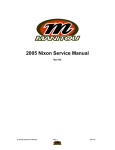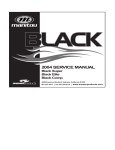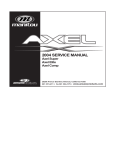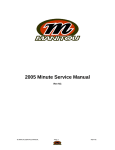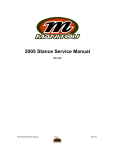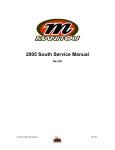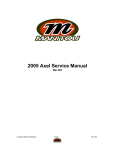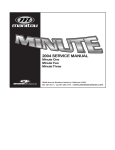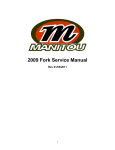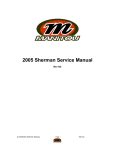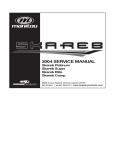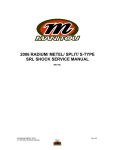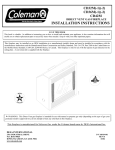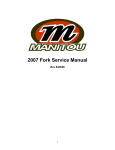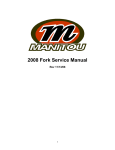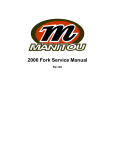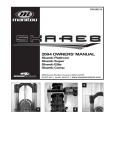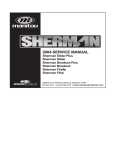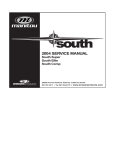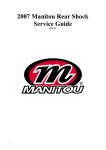Download 2005 Skareb Service Manual
Transcript
2005 Skareb Service Manual Rev NC 05 SKAREB SERVICE MANUAL Page 1 REV NC Table of Contents Description Page Introduction 3 Front Suspension Terminology 4 Disassembly/ Assembly Instructions 8 Lock Out Troubleshooting 14 Remote Lockout Service Instructions 15 Infinite Travel Adjustment System (IT) Instructions 17 Bushing Removal and Installation Instructions 22 Troubleshooting Chart 26 Skareb: Schematic and Technical Specifications 28 Skareb Service Kit Chart 29 Contact Information Answer Products Customer Service Department 28209 Ave. Stanford Valencia, CA 91355 Toll Free: Direct: FAX: E-mail: Web site: (800) 423-0273 (661) 257-4411 (661) 775-1798 [email protected] [email protected] www.answerproducts.com 05 SKAREB SERVICE MANUAL Page 2 REV NC INTRODUCTION This manual is intended to guide the user through basic service of Manitou Skareb front forks. Service is supported by the identification of common parts and assemblies that have been assembled into Service Kits. The purpose of this manual will be to describe conditions that may drive the need for service and to provide installation instructions for the kits. Due to the time-consuming nature of suspension fork service, at this time our primary focus is to offer service kits that minimize the amount of downtime and labor involved. Important information is highlighted in this manual by the following notations: WARNING Failure to follow WARNING instructions could result in severe injury or death to the person inspecting or repairing the suspension fork or the user. CAUTION A CAUTION a caution indicates special precautions that must be taken to avoid damage to the product. NOTE A NOTE provides key information to make procedures easier or clearer GENERAL WARNING: Suspension forks by design contain gases and fluids under extreme pressure and warnings contained in this manual must be observed to reduce the possibility of injury or possible death. Following these instructions can help you reduce the risk of being injured. Any questions in regards to the information in this manual should be directed to Answer Products Customer Service at (661) 257-4411. WARNING Suspension forks use compressed air to provide fluid pressure in the damping system and spring resistance in Air models. BOTH systems must be relieved of pressure prior to servicing these systems. Failure to relieve air pressure could result in injury or possible death. CAUTION: The Skareb suspension fork uses precision machined aluminum and other soft alloy components. Using correct tools for assembly is essential to prevent damage. 05 SKAREB SERVICE MANUAL Page 3 REV NC FRONT SUSPENSION TERMINOLOGY Air Cap – Top cap that threads into top of air/spring leg (this is the left leg of the fork as you are seated on the seat). Forks may be controlled with an air/spring or a coil spring. The air cap contains the Schrader Valve, which is used to control the spring rate or SAG of air forks. Air Spring – A mechanism that is used to control the SAG of an air fork. Arch – A support that connects the two outer lower legs of the casting so as to keep them moving in unison. Black Nitrate Leg Coating – New coating for steel stanchion legs that reduces stiction. Boss – The word used to describe an outer casting that has brake posts for V-brakes or cantilever brakes. Bottom Out Bumper – A rubber or elastomer device that absorbs the shock that occurs when a suspension is compression to its limit. Bushings – A cylindrical sleeve between a fork stanchion tube (inner leg) and a fork outer casting (slider), which facilitates the sliding movement between these two parts. Coil Spring Air Assist – A new feature for 2005 that utilizes a full length coil spring and allows you to increase the spring rate of the fork by adding air as a booster to that coil spring. Coil Spring – A coiled piece of metal that acts as a spring to help suspend a fork. Compression – The phase of the suspension operation in which the wheel travels up, or travels closer to the frame. The suspension forks reaction to a bump in the trail. Compression Damping – Restriction of the rate that the suspension compresses under load. Convertible Travel – A system used to alter the travel of a suspension fork. It requires moving a travel clip on the compression rod to a different position. This operation is accomplished by disassembling the fork and physically moving the travel clip on the compression rod. Crown Steerer Assembly – the stanchion legs (inner legs), the fork crown, and the steer tube pressed together as one assembly. This assembly is then finished by adding all of the fork internals and then outer casting (slider). Damping – A function that modifies the rate of suspension compression or rebound. Detent – An indentation that causes a rotating adjuster to stop at fixed increments. Drop Out – The end of an outer casting (slider) where the wheel attaches. Dust Boot – Usually a piece of rubber in the shape of a cylinder with baffles to allow it to compress as the fork compresses through its travel. Its function is to help keep dirt and water from getting into the inner legs of the fork. FFD – Fluid Flow Damping. A Manitou patented low cost oil damping system. The compression damping is non-adjustable and the rebound damping may be non-adjustable or adjustable damping. Fork Crown – The component that joins the stanchion tubes (inner legs) to the steer tube of the fork. 05 SKAREB SERVICE MANUAL Page 4 REV NC FRONT SUSPENSION TERMINOLOGY (CONT.) Hydraulic Fork Oil – Oil used in suspension designs to provide damping. It has special characteristics that determine how it reacts when exposed to compressed air, how it changes viscosity when its temperature changes, and how it moves through valves. Hydraulic Lock Out – a condition caused when the mixture of air and damping oil is out of balance. It is caused when there is too little air space in a chamber, not allowing the fork to compress through its travel. Infinite Travel System (IT) – A handle-bar mounted air travel adjust system that allows the rider to change the fork travel (and ride height) without a spring rate change. The travel can be changed from full compression to full rebound and at any place in between. Lock Out – a special function that restricts the compression of the fork from moving. It is generally controlled by an external knob that is activated when a rider does not want the fork to move, thus eliminating extra energy needed to overcome the bobbing forces of the fork. MCU – (Micro-Cellular Urethane) Special urethane that is filled with tiny air cells that act like springs when the elastomer is compressed. Micro Lube – Lubrication system that is operated by injecting small quantities of grease directly into ports that are inserted into outer casting legs. This enables the lubrication of the fork without having to disassemble it. No Boss - The word used to describe an outer casting that has no brake posts for V-brakes or cantilever brakes. This casting is to be used for disk brakes only. Oil Damping – A system that uses the resistance to oil flow through holes in a valve to provide a means to alter the rate of suspension compression or rebound. Oil Level – The level of damping oil needed for the optimal damping performance of a suspension. It is measured as the air space distance between the top of the stanchion leg (inner leg) and the height of the oil inside of the leg. The fork must be completely extended in order to get an accurate measurement. O-Ring – A soft, flexible neoprene or Buna rubber ring with a round cross-section, which is used for sealing and retention. Oil Weight – A description of the relative viscosity of oil, such as hydraulic oil. Oil with low weight numbers (5wt or 7wt) flows through the valving with less resistance than higher weight numbers (10or 15 wt). One Point Five Standard - 1.5 inch interface standard for frame head tubes, headset, cups, stem, and steer tubes which allows for the lightest weight and strongest design in 170mm single crown forks. This design greatly improves the control and steering precision of the fork. It is used predominately on forks with longer travel and the intended use is for more hardcore, extreme riding. Outer Casting – (see Slider) Preload – A condition of compressing a spring or elastomer before the operating loads are put on the suspension, so that it provides a stiffer spring rate. 05 SKAREB SERVICE MANUAL Page 5 REV NC FRONT SUSPENSION TERMINOLOGY (CONT.) Piston – In front suspension, the part of the damper that slides back and forth inside of the damping leg that houses the valves. It can also refer to the air piston in the air/spring assembly that slides back and forth compressing the air, thus causing a change in the spring rate of the suspension. Porosity – The condition or property of having pores in a material that will allow gas or liquid to pass through it. Platform Plus Damping – A new damping system found on 2005 Rear shocks (featured on Metel and Radium’s). This system will establish a pedaling efficiency platform similar to SPV, but is done through unique valving that is not adjustable (helps in bump control). Rapid Travel II, Wind Down – Systems that are used to control the travel of suspension forks. Also known as RTII, and WD. RTII is used for the specific purposes of controlling the travel in two conditions: climbing and descending. WD is an incremental travel adjustment between to set limits and does not affect the spring rate of the fork as severely as RTII. Quad Ring seal – New seal that replaces standard o-rings in designs that require more efficient air and oil sealing methods. Rebound – The phase of the suspension operation in which the wheel returns to its original position on the ground after compression. Rebound Damping – Restriction of the rate that the suspension rebounds when the compression load is relived. Remote Lock out system – A handle-bar lever actuated system that controls the lock out function on front and rear suspension products. Reverse Arch Technology – Also known as RA. It is a system that is designed to move the arch of a fork to the backside of a fork, rather than the conventional front position. It was designed to provide greater rotational torque strength to an outer casting (slider), without adding additional weight to the fork. Sag – The amount a suspension fork compresses at rest with a normal load (rider’s weight). Schrader Valve – Valve used to introduce air into a chamber. Seal – A part, usually neoprene rubber or Buna, that keeps contaminants out and/or working fluids in. Semi Bath – A lubrication system that uses a lubricating oil to keep the bushing surface and stanchion legs (inner legs) as friction free as possible during movement of the stanchion legs. Spring Rate – The rate at which the resistance of a spring increases as it is compressed. SPV – (Stable Platform Valve) new damping system that allows the rider to set the pedaling platform that he desires to pedal most efficiently in all situations. It is dependent on the pressure that the SPV valve experiences from the movement of the wheel vs. the terrain and the platform that is set by pressure introduced to other side of the SPV valve through changes of air pressure working on the damping oil. SPV Evolve – The latest version of SPV damping technology that has increased its performance with modifications to the original design. 05 SKAREB SERVICE MANUAL Page 6 REV NC FRONT SUSPENSION TERMINOLOGY (CONT.) Slider/Outer Casting – The tube (outer casting leg) of the suspension fork that0. remains fixed to the wheel. It slides up and down on the stanchion leg (inner leg). Stanchion Clamps - (Double-Triple Clamps) the portions of the fork crown that clamp around the stanchion legs above and below the head tube of the bicycle frame on specific long travel applications. Stanchion Legs – The suspension tube (inner leg) fixed to the fork crown. It remains stationary during the operation of the suspension. Steer Tube – The long cylindrical tube that extends from the top of the fork crown. Its function is to be inserted into the bicycle head tube and attach the suspension to the bicycle frame. Thru Axle – (Hex-lock) A device used for mounting a thru axle hub to special outer legs that are not made for standard quick release hubs. Manitou’s Hex-lock (thru axle) system is a special patented system utilizing a hex shaped end that increases the stiffness of the fork and reduces slippage in the joint between the axle clamps and the axle. Top Out Bumper – A rubber, coil spring, or elastomer device that absorbs the shock that occurs when the load is taken off a suspension so that it is allowed to rebound to its limits TPC – (Twin Piston Chamber) a patented damping system that has independent pistons for rebound and compression. The system utilizes a mixture of air and oil in the damping leg of the fork to enhance the damping performance. TPC+ - A variation of TPC that has added a floating piston to the compression damper to enhance the performance of the compression damping under the load of bigger hits. Travel – The amount that a wheel moves between the most compressed and the most extended states of the suspension Viscosity – A description of how a liquid flows. Liquids with higher viscosity are thicker flow less easily or quickly than liquids with low viscosity. This has an affect on the damping speeds of rebound and compression. Volume Control – A new system designed to work with SPV as a control of the compression ramp up rate of the fork. It has a range of adjustments from linear to very progressive. Wiper Seal – A rubber material that is used as a seal to keep dirt and water out of the outer casting legs. It is not designed to keep air pressure or extreme oil pressure in. Manitou has the new Evil Genius wiper seals. 05 SKAREB SERVICE MANUAL Page 7 REV NC 2004 Skareb Forks Disassembly and Rebuild Instructions Disassembly Instructions Removal of Outer Casting 1. From the left leg dropout (Left when sitting on the bike), use a 4mm hex wrench to remove the compression rod screw. 2. From the right leg dropout, if the fork has adjustable rebound, the knob will need to be removed. Remove the 2mm hex screw inside the knob and remove the knob. 3. Use a 8mm hex wrench to turn the damper clockwise until it can be pushed into the casting. 4. Remove crown/steer/inner leg assembly from the outer leg casting. 5. Position the bottom of the fork legs over a drain pan that is on the ground. Pull the casting downward towards the pan, allowing the Semi Bath oil in the casting to drip into the pan. Pull the casting completely off of the inner legs and wipe any excess oil off of inner legs and inside of casting. Bushing Removal & Installation Please refer to section on Bushing Removal & Installation. Removal of Compression Damping Assembly Forks with FFD (non-adjustable) Damping 1. Remove top leg cap (FFD Assy) on right hand side using 27mm socket. 2. Pour old oil out of the top of the fork, then compress fork upside down over oil drain pan 3-5 times to get oil out from under rebound piston and discard appropriately. Forks with Adjustable Compression/Lockout Damping 1. 2. 3. 4. Remove the 2mm fixing screw on top of the damper knob on top right side of the fork. Remove 2 balls and springs from inside the top cap. Unscrew the compression damping assembly using a 24mm socket. Pour old oil out of the top of the fork, then compress fork upside down over oil drain pan 3-5 times to get oil out from under rebound piston and discard appropriately. Removal of SPV Compression Damping Assembly WARNING This fork uses compressed air as part of the SPV damping system and must be relieved of pressure prior to servicing. Failure to relieve air pressure could result in injury or possible death. 1. If your fork has a red Schrader cap on the top right side of the fork, it is equipped with SPV damping. Remove Schrader valve dust cap from Red Hex Shaped Top Cap on the top right of the crown. Release all air pressure from the Schrader valve. 2. Remove SPV Volume Control Cap (Red Hex Shaped Top Cap) from top right of the crown with a 24mm Socket. Turn fork upside down over drainage pan to empty Damping oil from the inner leg. Stroke the Damper shaft on the bottom of the inner leg 3-5 times to purge the leg of oil that is caught below the oil piston. 05 SKAREB SERVICE MANUAL Page 8 REV NC Removal of Rebound Damping Assembly 1. Unscrew Damper end cap from the bottom of the right leg and then pull out the rebound damper. Removal of SPV Rebound Damping Assembly 1. If your fork had a red Schrader cap on the top right side of the fork when removing the compression damper above, it is equipped with SPV damping and will have the companion SPV rebound assembly. Unscrew damper end cap from the bottom of the right leg using a 24mm Open-end wrench or 8-10” Adjustable wrench and then pull out the SPV rebound assembly. 2. Checking the function of the SPV valve - Visually inspect the gap between the SPV valve and the bottom of the damping piston. It should have approximately 1mm of space. The valve should also spring back to its open rested position after compressing it with your fingers. If the valve is not responsive or all the time closed, it is bad and the rebound assembly needs to be replaced. Check for 1mm gap between the blue SPV valve and the black piston Removal of Air Piston and Compression Rod Assembly There are now two ways to remove the air piston from the inner leg. 1. An Air Piston Removal tool has been developed that will enable you to remove the piston without having to take the fork apart. (P/N: 85-8062). 2. Without this new tool, you will need to follow the procedures in the following section. WARNING This fork uses compressed air to provide spring resistance and must be relieved of pressure prior to servicing. Failure to relieve air pressure could result in injury or possible death. 1. Remove air dust cap covering the Schrader valves. a. Depress Schrader valve to release air pressure. b. Remove air cap on top of Left leg with 20mm socket. 2. Remove rebound adjuster knob using a 2mm hex wrench. 05 SKAREB SERVICE MANUAL Page 9 REV NC 3. From the right leg dropout, use 8mm hex wrench to turn the damper shaft clockwise until it can be pushed into the casting. 4. Remove 11mm hex bolt (Compression Rod bolt) from bottom of Left leg. 5. Remove crown/steer/inner leg assembly from the outer leg casting over a drain pan, because Semi Bath oil will leak out of bottom of casting once you pull the inner legs from the outer casting legs. 6. Be sure to drain all Semi Bath oil out of casting before re-assembly of fork. 7. Remove left leg end cap and compression rod assembly from inner left leg. Then remove spring and Air piston rod. 8. Use a long narrow rod approximately 18”/458mm long and no greater than ¼”/7mm in diameter and insert it into the left inner leg from the bottom of the leg. Be sure to direct the rod through the center of the negative spring assembly that is about halfway up the inner leg. Once the rod has contacted the air piston, use a rubber mallet and tap the piston out through the top of the inner leg. Tapping Piston out with long rod Assembly Instructions Assembly of Air Piston and Compression Rod Assembly WARNING All leg caps for Damper and Spring systems must be properly tightened prior to use. Failure to do so could result in injury or possible death. 1. Apply a small amount of Prep M grease onto the threads at the top of the left inner leg with your finger. 2. Apply a small amount of Prep M grease around the outside diameter of the new air piston. 3. Insert the air piston (metal side up) into the inner leg through the threaded area at the top of the inner leg. Use your fingers to push the piston past the threads into the leg. Air Piston is inserted into inner leg with metal side facing up 05 SKAREB SERVICE MANUAL Page 10 REV NC 4. Re-install the air push rod, positive spring (that has been well greased), and compression rod assembly. Tighten per the Fastener and Torque Values section. 5. Pour about 3cc of a 40wt or greater automotive oil into the top of the piston and then install the air cap assembly. Tighten the air cap assembly 30-50in/lbs. Make sure to apply a thin layer of grease to inner threads and outside of piston before installation. Pour 3 cc of oil into top of piston 6. Fully extend the damper shaft and slide the rubber bumper against the inner leg end cap. Insert the crown/steer assembly into the outer legs to the upper bushing. Holding the fork horizontal, inject 16cc of 5-40wt Semi bath oil into the hole at the bottom of each outer leg (Figure 2). A syringe works well for this procedure. 7. Push the outer legs past the lower bushing and reinstall the 4mm bolt and tighten 8mm damper fitting in a counterclockwise direction. Tighten per the Fastener and Torque Values section. 8. Use a shock pump (p/n 85-4069) to fill the air system to the recommended levels as outlined in the Fastener and Torque Values section. Reassembly of Crown Steer/Leg Assembly WARNING All top caps for Damper and Spring systems must be properly tightened prior to use. Failure to do so could result in injury or possible death. WARNING All leg caps for Damper and Spring systems must be properly tightened prior to use. Failure to do so could result in injury or possible death. 1. Grease the outside of the air piston and then apply a thin film of grease to the threads at the top of the inner leg. It is recommended to use Prep M grease (P/N: 85-0031). Push the piston into the top of the left inner leg with the metallic side of the piston facing you, using your thumb. Push the piston past the threads and then pour approximately 3-4cc’s of a 20-50wt oil (P/N: 85-0022) into the top of the piston. This oil needs to be checked about every 6-8 weeks of riding time. It will dissipate over time and then you may experience some air leakage and increased stiction in the fork movement. 2. Install the air cap and tighten it to value given on fork schematic. 3. Turn crown/steer/leg assembly over, so that the bottoms of the inner legs are facing you. In the same leg that you just installed the air piston and air cap into; insert the air push rod (longer end in first), then the positive spring (this is your ride kit spring) onto the short end of the push rod, then install the compression rod assembly, and tighten end cap into leg. Tighten to torque values that are listed on fork schematic. 4. Now, install damping assembly into bottom of other inner leg. If your fork uses SPV damping, be sure to check the function of the SPV valve and apply a thin layer of Prep M grease onto 05 SKAREB SERVICE MANUAL Page 11 REV NC o-ring that is around the piston at top of assembly. Install the assembly and tighten end cap to specified torque value. Assembly of Compression Damping Assembly - Non-Adjustable FFD WARNING All top caps for Damper and Spring systems must be properly tightened prior to use. Failure to do so could result in injury or possible death. 1. Put a little bit of Prep M grease (Ref Answer Products PN 85-0031) on o-ring found on the lower piston of the FFD assembly. 2. Install the FFD Assy into the top right hand of the crown/steer using a 27mm socket. Tighten per the Skareb Schematic and Torque Specification Table. Assembly of Compression Damping Assembly - Adjustable Compression/Lockout WARNING All top caps for Damper and Spring systems must be properly tightened prior to use. Failure to do so could result in injury or possible death. 1. Fill right leg with damping oil using 5wt Motorex fork oil (Ref Answer Products PN 850023) to the height noted in the Skareb Schematic and Torque Specification Table. Cover the opening at the top of the right leg of the crown/steer with a rag and cycle the fork six times. Recheck oil level and add/drain to meet the level requirement. 2. Put a little bit of Prep M grease (Ref Answer Products PN 85-0031) on the urethane or brown rubber o-ring found on the lower piston of the Lock out assembly. 3. Twist the Hex shaped aluminum shaft that sticks up from the top cap counter clockwise until it stops (the system is completely open to oil flow at this point). 4. Using a motion like screwing in a screw. Twist the assy. and apply a little pressure to insert the piston part of the mechanism past the threads at the top of the inner leg. Then push the assy. into the leg until the threads on the cap intersect the threads inside the inner leg, screw the cap. Tighten per the Skareb Schematic and Torque Specification Table. 5. Once the cap is tightened, twist the Hex shaped shaft clockwise until it stops (this is the locked out position). Insert the springs into opposite holes in the top cap and then place the ball bearings on top of the springs (place a little dab of grease on spring to hold ball bearing in place). 6. Place the adjuster knob onto the hex shaped aluminum shaft and seat it onto the top cap and ball bearing. Position the adjuster cap so that the lever part of the cap is at the farthest point to the back of the crown. 7. Insert 2mm fixing screw and tighten to secure the knob. Twist the knob counter clockwise to activate the fork suspension. Compress the fork several times to circulate the oil through the system and then activate the Lock out system by moving the lever clockwise to its stopping point at the back of the crown. The fork should have approximately 5 mm of progressive travel before it locks out. Note: This system is a combination of adjustable compression damping that becomes a lock out. It is fully active when the lever is facing all the way forward (counter clockwise) and locked out when the lever is facing all the way towards the back of the crown (clockwise). Assembly of Compression Damping Assembly - SPV WARNING All top caps for Damper and Spring systems must be properly tightened prior to use. Failure to do so could result in injury or possible death. 1. Insert the Volume control assembly into the top of the right inner leg and tighten per the Skareb Schematic and Torque Specification Table. Be sure that you unscrew the red 05 SKAREB SERVICE MANUAL Page 12 REV NC 16mm Hex shaped Volume control nut all of the way counterclockwise after you tighten the entire assembly into the inner leg. Use: the Manitou Volume Control Adjuster (P/N: 85-3007) to do this. Installation of Outer Leg Casting WARNING When installing the outer Leg Casting to the Crown Steer Assy, Compression Rod bolts and Damper Shafts must be properly tightened prior to use. Failure to do so could result in injury or possible death. 1. Turn completed crown/steer/leg assembly upside down, so that the compression rod and damper shaft are facing you. You will see a bottom out bumper on the damper shaft; slide this bumper down towards the end cap that is threaded into the inner leg. This will help in keeping the shaft extended as you install the outer casting. 2. Pressurize the air spring to 100psi; this will help keep the compression rod extended as you install the outer casting. 3. Press inner legs into casting about half way and then inject Semi Bath oil (5/40wt. synthetic oil, P/N: 85-0022) into outer casting, holding fork at 45 degree angle to the ground with bottom of fork in the air (drop outs up). Inject 16cc’s of oil into each outer leg. It is recommended to use a syringe to inject oil. 4. Finish sliding inner leg assembly into outer leg casting until damper shaft contacts casting. 5. Use an 8mm hex wrench to turn the damper shaft counterclockwise, threading it into the casting. Tighten per the Skareb Schematic and Torque Specification Table. 6. Install rebound adjuster knob if applicable. Knob should turn uninhibited until the indicator is stopped by the casting. If not, remove knob and reinstall on hex shaft in 1/6 turn increments until full travel is reached. 7. Install the 4mm compression rod screw and tighten per the Skareb Schematic and Torque Specification Table. 05 SKAREB SERVICE MANUAL Page 13 REV NC Lock Out Troubleshooting Tips Installation of Lock out Compression Damping System • Check the o-ring that is installed around the lower piston on the damper shaft for tears or deformation. Replace it, if it is damaged. This is the most common reason why the Lock out system will not function. • Check the level of oil in the inner leg. The oil level may be a little high, but never low. The oil level must be high enough to cover the window that opens and closes on the damper shaft. • Make sure that the oil flow window on the lower portion of the damper shaft, positioned right above the piston, opens and closes when you move the lock out knob from open to close. • Inspect the rubber o-ring that is around the threaded portion of the cap that screws into the inner leg of the fork. This o-ring should not have nicks or tears in it and should fit tightly around the cap. • Make sure that when installing the Lock out system into the fork leg that you follow this procedure: Put a little bit of Prep M grease on the urethane o-ring, make sure that that the oil flow window is open using a motion like screwing in a screw. Twist the assy. and apply a little pressure to insert the piston part of the mechanism past the threads at the top of the inner leg. Then push the assy. into the leg until the threads on the cap intersect the threads inside the inner leg, screw the cap in and do not use any tools to over tighten the cap. Once the cap is tightened, compression the fork several times to circulate the oil through the system and then activate the Lock out system by moving the lever to the other position. The fork should have between 2 & 5mm of progressive travel before it locks out. 1. Troubleshooting • If the Lock out does not lock out properly, go back through the steps listed above. • If the o-rings are damaged on the Lock out piston, replace them with P/N 062594(urethane 1998-2003 Mars, SX, & Skareb Lock outs), 065261 (04/05 Skareb Lockouts) and 02/03 Black 100/120mm Lock outs, and 040315 (Axel’s). • If the oil level is low, check to see if there is evidence of leaking at the Rebound Damper. If so, replace the Rebound Damper assembly and retry the Lock out. The oil level may be low if you are upgrading a standard Compression Damping system with the Lock out system. In this case, make sure the oil level is at the correct level before trying it again. If there are signs of oil leaking around the top of the Lock out system, check the rubber o-ring (040524) and replace if needed. If the window does not open or close when the knob is moved, replace the entire Lock out assembly. 05 SKAREB SERVICE MANUAL Page 14 REV NC Remote Lock out Service Instructions Complete Remote Lock out Assembly Lever Kit and Lever cover Kit Cable Guide There are (5) Service kits available for each fork model that utilizes a Remote Lock out. 1. Lever assembly 2. Lever Cover 3. Cable assembly 4. Cable guide 5. Lock out assembly *Reference to these kits may be found in the Service Parts Matrix Instructions for removing assembly from fork Barrel adjuster Cable Assembly 1. Lock out Assembly 2. 3. Tools needed to service assembly 4. 5. Unscrew barrel adjuster in a counterclockwise direction until it stops. Remove Lever cover by squeezing the two plastic prongs together on the under side of the lever and pulling the cover in an upwards direction from the lever assembly. Pull on Black cable ferrule nearest to lever and pull cable assembly from the groove in the Lever assembly, thus releasing cable from lever. Unhook cable end from lever. Unscrew the top cap of the Lock out assembly from the fork crown using socket (Answer p/n: 83-2503) or an adjustable wrench. Pull Lock out assembly out of crown by twisting the assembly like unscrewing a screw and applying an upward pressure. Slowly pull assembly out of crown and watch out for some excess damping oil to come out of inner leg as the piston at the end of the assembly comes out of crown. Adjustable Pliers Adjustable Wrench Socket Wrench 22mm Socket W/cut out 10mm open end wrench Please continue to next page for more Service instructions 05 SKAREB SERVICE MANUAL Page 15 REV NC Steps of Cable Disassembly 1. 2. 3. Step 3 Step 1 Step 2 4. 5. Tool Placement to unscrew upper shaft assembly from lower assembly (Figure A) 1. 2. 3. Cable hook up connection (Figure B) 4. 5. Cable Replacement Instructions Step 1: Lock out assembly should be out of fork at this point. Step 2: Cable assembly should be out of Lever assembly Step 3: Look at tool placement in Figure A. It is recommended to use the Adjustable Pliers to grasp the flange of the lower assembly right above the coil blow off spring. Use a 10mm open end wrench on the flats of the upper assembly just below the top cap. Hold the flange with the Pliers and turn the 10mm wrench in a counterclockwise direction in order to unscrew the upper and lower assemblies. Separate the two assemblies and unhook the cable end from the eye hook as shown in Figure B. Pull the cable out through the top cap and red cable guide. There will also be a 75mm spring inside of the upper shaft. This spring provides the tension for the cable when you move the Lock out lever from the Lock position to Unlock position. The inner cable runs through the center of the spring. Cable Installation Instructions The inner cable is not removable from the cable assembly. The entire cable assembly must be replaced. Install the new cable assembly by reversing the Disassembly the instructions. Slide the inner cable through the red cable guide, the top cap, and down through the spring. (Be sure to put a little bit of the Prep M grease on the spring before putting it back into the upper shaft assembly.) Push the cable assembly together, forcing the inner cable to stick through the spring and then out through the end of the upper shaft assembly. (See Figure C). Hook the cable end into the eye hook and then pull on the cable assembly to pull the two shafts together. Tighten them together snuggly. Check oil level in fork leg (refer to oil level heights in fork spec sheets). Install Lock out assembly into the fork leg and tighten top cap to proper torque. Re-install the other cable end into the Lever assembly, and then put the lever cover back on to the Lever assembly. You may have to pull the cable assembly away from the housing of the lever assembly to expose the inner cable, so that you can slide the cover into its proper position. Figure C 05 SKAREB SERVICE MANUAL Page 16 REV NC Infinite Travel System (IT) Lower Assembly IT System Disassembly Instructions 1. 2. 3. 4. 5. 6. 7. 8. 9. Remove front wheel and brake set from fork. Important: you must remove all of the air from the left leg of the fork before disassembling the IT System. There may also be a discharge of a white substance when you depress the Schrader valve core (this is similar to the discharge when you depress the valve core on any of the Manitou Air or SPV forks). On the bottom of the left leg (leg that has the Disk Brakes mounts on it), there is a Schrader valve protruding from it. Unscrew the valve cap and follow either of these two methods for releasing all of the air from the system. A. Depress the valve core and let all of the air out. Now depress the IT lever on the bike’s handlebar and release it. Once again, depress valve core in the Schrader valve to release any air in the leg. Do this a couple of times, until all of the air is released. B. If you have a helper, have them hold the IT lever on the handlebar down as you depress the valve core. This will let all of the air out at one time. Now that all of the air is released, unscrew the 12mm nut that is threaded onto the Schrader valve. It is recommended to either turn the fork upside down or hold it right side up over a drain pan to catch the Semi Bath lubrication oil that will come out of the bottom of the casting as you start the procedure of removing the casting. (see Fig 1) Move over to the bottom of the right leg and unscrew the 2mm Allen screw from the middle of the rebound adjuster knob. Pull the knob away from the bottom of the casting leg exposing a recessed 8mm hex. Use an 8mm Allen Wrench and turn it in a clockwise direction in order to unscrew the rebound damper shaft from the casting. You can now remove the casting, exposing the fork’s inner legs. Be aware that there may be some of the Semi Bath oil in the casting after you remove it. Use an Adjustable Wrench and unscrew the black end cap that is threaded into the bottom of the left inner leg. Pull the lower IT assembly from the inner leg. There may be a very little amount of oil that comes out of the inner leg as you remove the lower IT assembly. This is the lubricating oil used to allow the air piston on the lower shaft assembly to move freely. 05 SKAREB SERVICE MANUAL Air Piston Upper Assembly IT Lever Assembly Top Cap & Cable Guide Inner & Outer IT control wire IT System Components 22mm slotted socket Adjustable Wrench 12mm Wrench Valve Core Tool Service Tools Needed Page 17 REV NC Disassembly Instructions continued 10. Now it is time to remove the IT upper assembly. Release the IT control wire from the control lever by unscrewing the fixing screw on the lever that holds the cable tight. Use a 2mm Allen Wrench to unscrew this screw and then pull the cable out of the lever. (Go to Fig 2 for next step) 11. To remove the upper IT assembly, use a slotted 22mm 6 point socket (P/N: 83-2503), a 22mm Open End wrench, or an adjustable wrench. (Note: Be aware of the IT control Wire spinning around when unscrewing the top cap) 12. Pull the upper assembly out of the inner leg. Troubleshooting Tips 1. Figure 1 Here is a guide to help pinpoint fork travel issues. ** If the fork starts to lose travel from an extended position to a shorter position by itself, the damage is most likely centered on the Quad ring around the outside of the piston. **If the fork extends from a shorter travel to a longer travel by itself, the failure can be involving the smaller Quad ring that is located under the piston on the inside diameter of it where the shaft of the upper assembly intersects the lower assembly and piston. The shaft is sealed against leakage at this point to define the two different chambers. A. Always check two things when you have the system apart. ***Use a straight edge and lay it next to the inner shaft that is attached to the top cap of the upper assembly to insure that that shaft is not bowed at any point. We found that on assembly of these pieces, the shaft is pressed into the top cap and if it is over pressed, the shaft will bow. This means that at where the bow is in the travel of the shaft, it will cause the Quad ring that it is passing through, to distort. Thus air transfers from one chamber to the other and the fork will extend by itself. If this is the case, you will need a new top assembly and an O-ring kit. (Refer to Figure 3) ***Make sure that the valve core in the Schrader valve is tight and does not stick open or closed. If this is faulty, replace this valve core with a new one. Any bicycle tube valve core will work, as well as any valve cores that we currently use on any of our other products. B. On the lower assembly, inspect the Quad ring that is around the piston at the top of the lower assembly. You are looking to see if it is seated properly and not torn or twisted. Also inspect the piston to see if there are unusual wear marks on the piston on one side of the piston only. If this is a wear spot, then this means that the hole in the bottom of the casting is slightly off center and the casting needs to be replaced with a new one. (Refer to Figure 4) (Continued on next page) Figure 2 Figure 3 Figure 4 05 SKAREB SERVICE MANUAL Page 18 REV NC Troubleshooting Tips continued This condition causes the Lower shaft assembly to be side loaded inside of the inner leg and causes wearing of the piston that allows for a poor fit of the Quad ring and thus an air leak C. The last item to be concerned with is the casting. When reassembling the fork, be sure to visually inspect the position of the bottom of the lower assembly as it begins to come through the bottom hole in the casting before you secure it with the 12mm nut. If that shaft is not guiding itself straight through that lower hole without any assistance, you will eventually see the same issue as mentioned above. Once again it is a casting issue. (Note: Always replace all o-rings and seals provided in the IT O-ring kit, each time you take the system apart) IT Control Wire Change 1. In order to change the inner control wire, start by following IT disassembly steps 2, 3, 10, 11, & 12. 2. Once you have the upper assembly out of the fork, use the adjustable wrench and the 12mm Open End wrench to unscrew the top cap from the shaft of the assembly. Refer to Figure 5 at the right. 3. As you unscrew the top cap, you will feel a little tension created by a spring that is under the cap. Separate the top cap from the shaft once you have completely unthreaded the two pieces. 4. Pull on the inner wire in order to remove the machined stopper with the cable end in it from the shaft. 5. You can now unhook the cable from the stopper and from the cable head end, pull the cable through the spring, the top cap, and the outer cable housing. Refer to Figure 6 at the right. 6. Reverse the above steps to replace the cable. (Note: The inner cable can be replaced with a standard bicycle Derailleur cable) (It is recommended to replace the two O-rings on the stopper each time that it is removed from the shaft, in addition to the Black Buna O-ring that is on the shaft below the threads.) 7. Tighten top cap on the shaft to 25inlbs (2.85Nm). 8. Put a small amount of Motorex grease on the end of the Upper Assembly shaft, and then insert the assembly into the fork inner leg. 9. As soon as contact is made with the hole in the top of the air piston/lower assembly, twist the upper assembly like screwing in a screw to guide the upper assembly shaft into the hole without damaging the Quad ring seal in the shaft of the lower assembly. 10. After reinserting the upper assembly into the fork but before screwing the top cap in, pour about 6-8cc’s of 40wt. automotive oil into the fork leg through the top of the crown. Figure 5 Top Cap Spring Machined Stopper Shaft with Buna O-ring Figure 6 05 SKAREB SERVICE MANUAL Page 19 REV NC 11. Feed the inner wire through the cable housing and secure one end of the of the housing into the gold cable guide, then feed the end of the inner wire through the hole in the black cable stop on the lever. 12. The inner wire now feeds through the hole in bottom of the lever, over the top of the lever and through the hole in the back of the lever. 13. Pull the inner wire until there is no slack in the cable. Be sure to set a 2mm gap between the front of the lever and the top of the cable stop to insure 7 gap that you have notFigure over tightened the cable2mm before you tighten the 2mm Allen bolt on the front of the lever to cinch the inner wire. (Refer to Figure 7) 14. The last step is to cut the inner wire that is left hanging on the backside of the lever and then installing the cable end to prevent it from fraying. Figure 7 2mm Gap Replacement of Piston Quad Rings 1. 2. 3. 4. 5. 6. 7. In order to replace the Air piston Quad rings, you need a 12mm Open End wrench and an adjustable wrench. Refer to Figure 8 for wrench placement. Hold the 12mm wrench in place on the flats that are on the piston seat and turn the piston with the adjustable wrench in a counter clockwise motion to unscrew the piston from the shaft. Once the piston is off of the shaft, you will see a small Black Quad ring inside the top of the shaft that you just unscrewed the piston from. Use a small diameter object to remove the Quad ring from the shaft. Replace this Quad ring with a new one from your IT O-ring kit. Be sure that it is seated in the shaft and rests flat against the shelf inside of the shaft. (Refer to Figure 9) Install the Air Piston back onto the shaft in the reverse of the way you removed it. Tighten the piston to 15inlbs (1.7Nm) onto the shaft. To remove the large Quad ring on the outside of the piston, grasp the piston at the Quad ring like you would pinch someone with your thumb and pointer finger. Squeeze the Quad ring and you will see a section of the Quad ring move away from the piston. Use the same tool that you used to remove the small Quad ring from the shaft and pry the Quad ring off of the piston, being careful not to scar the surfaces of the piston. Discard this Quad ring and replace it with a new one. Be careful not to twist it in the seat that it rests in. You are now ready to reassemble the IT system. Figure 8 Figure 9 Note: Always change all Quad rings and orings when servicing the IT system 05 SKAREB SERVICE MANUAL Page 20 REV NC Reassembly of the IT System 1. 2. 3. 4. 5. 6. IT Service Kits It is recommended that when reassembling the IT system that you start by installing the lower assembly into the bottom of the inner leg first. Be sure to apply a small amount of Prep M grease to the Quad ring on the outside of the piston and onto the threads of the inner leg before inserting assembling into leg. Twist shaft assembly as you insert piston past the threads of inner leg. Tighten end cap to 2535inlbs (2.8-3.9Nm). Refer to steps 8, 9, and 10 above in the “IT Control Wire Change” for installation of the top assembly. Once this assembly is installed; the casting can be installed, Semi Bath oil added, and all fasteners secured. When re-inflating the IT system, it is fastest if you have someone depress the control lever and hold it while you pump air into the system. This way the system equalizes immediately. If you do not have a second person to help, just add air to the system and then periodically depress the lever to equalize the pressure. This may have to be done a couple of times in order to reach the required air pressure. It is recommended to initially set your fork up with an air pressure that is approximately 75% of your rider weight. Then you can fine tune your ride by adding or deleting air as you need. Lever Kit Assembly Lower Assembly 05 SKAREB SERVICE MANUAL Page 21 Cable Guide Top Assembly REV NC Bushing Removal & Installation Bushing Removal (Note: use appropriate removal ring that corresponds to the leg diameter of the fork being repaired) Leg Diameter 25.4mm (1”) 28.6mm (11/8”) 30mm 32mm Answer Kit # 85-5191 85-5189 85-5194 85-5192 Bushing Removal Tool Components A. Slide Hammer B. Threaded Handle C. Slide D. Threaded Shaft E. Removal Ring Bushing Removal Tool Assembly 05 SKAREB SERVICE MANUAL Page 22 REV NC Bushing Removal (CONT.) Bushing Removal Instructions A. Install 25.4mm Removal ring on the shiny, smaller diameter threaded shaft. Be sure to install the ring with the tapered, chamfered end first, followed by the long slide tube. This tapered end leads the tool through the bushing. B. Start the procedure by removing the Dust/Wiper seal with a screwdriver, prying it out. C. Insert Removal tool past the upper bushing and then stop. It is important to pull one bushing out at a time. Push the slide on the threaded shaft down towards the removal ring. Hold the casting with one hand and the slide hammer with your other hand. Now move the slide hammer in a motion away from the casting and repeat this action until the bushing comes out. D. For all other leg diameters: use the larger diameter (dark colored) threaded shaft and repeat steps A-C. Bushing Installation (Note: Sizer kits listed in above chart contain the sizers needed for each specific leg diameter.) (1) (2) Bushing Installation Tool Components 1. Installation Mandrel 2. Threaded Rod w/nuts 3. Sizer rings 4. Spacer 5. Washer 6. Nut (3) 05 SKAREB SERVICE MANUAL Page 23 (4) (3) (5) (6) REV NC Bushing Installation (CONT.) Bushing Installation Tool Assembly With weighted handle When selecting sizer rings to install bushings, choose the two rings that are in the middle of the size run to start with. 1. Assemble installation tool as shown in picture above. Each leg diameter kit has all of the needed pieces to remove and install bushings for forks with serviceable bushings. Some of the kits come with gauges to tell you how far to drive in the lower bushings. Upper bushings are driven in as far as the stop in the top of the casting will allow. The general rule of thumb is that the lower bushings must not be driven any deeper than 5” into a casting leg. If they do go deeper, call Customer Service at Answer Products – 800-4230273 for a new outer casting. 2. Always assemble Mandrel with the larger diameter sizer ring being placed on the mandrel first, then the spacer, the next largest sizer ring, followed by the washer and the nut to hold it in place. Be sure to lock the nut above the Mandrel and below the Mandrel against each other. 3. Replace the lower bushing (bushing with a thicker wall diameter) first. Place a small amount of Prep M grease onto the sizer rings to help the rings come through the bushings when pulling them out. Slide bushing onto Mandrel until it stops. Apply a bead of Red Loctite all the way around the outside of the bushing. Hold casting on top of bench with a rag under the end of the legs and insert installation tool with bushing into casting leg. 05 SKAREB SERVICE MANUAL Page 24 REV NC Bushing Installation (CONT.) 4. Slide weighted handle onto end of threaded rod and tap rod into casting with rubber Mallet until proper depth is achieved. If using depth gage, slide gage onto rod before installing weighted handle and let it settle on of Mandrel. Tap rod until appropriate line on gage is even with top of casting leg. 5. Remove weighted handle and gage (if applicable). 6. For sizing of the lower bushing: 7. Use slotted top cap from sizer kit and set it into the top of the casting leg, straddling the threaded rod. Spin the extra nut with washer down to the top cap and using a wrench, socket, or speeder wrench, tighten the nut in a clockwise direction. This will cause the Mandrel to be pulled through the bushing, thus sizing it. Keep turning the nut until the tool is all the way through the bushing and can be pulled out of the leg. 8. To install top bushings, repeat steps B-E. Note that the top bushing gets inserted until it stops against the step inside of the casting. The extra sleeve that comes with the sizer kit is used to space the top cap off of the casting, so that there is enough room to pull the sizers out of the casting without bottoming on the cap. 9. If you find that the bushings are too tight after installing them, use the sizer Mandrel that does not have a stop on it to hold the bushing while installing it into the casting. This is available in the 25.4mm leg kit (85-5191) to go back in and resize the bushings. 10. To resize bushings, Choose the next larger size rings and repeat the above process. 11. When satisfied with the results, reinstall Dust/wiper seals and then reassemble fork 05 SKAREB SERVICE MANUAL Page 25 REV NC TROUBLESHOOTING Symptom Air Loss Oil leaks from Wiper Seals Oil leaks from bottom of Casting Lack of Travel Loss of SPV damping Cause Service Manual Page Solution Schrader Valve leaks Tighten Valve core, replace bad parts as needed. 10 Air Cap O-ring leaks Make sure O-ring is seated properly, replace parts as needed. 9 Air Piston leaks Check oil volume on top of piston, replace parts as needed. 9 Air Top Cap leaks Check O-ring, tighten cap to proper Torque, replace parts as needed. 9 Seal not seated properly Remove Casting from Inner Legs, reinstall or replace seals 8 Nicks or scratches on inner legs Replace Crown/Steerer/Inner Leg Assembly 8 Too much Semi Bath oil Follow instructions for removal and installation of Outer Casting 13 Wear Remove Casting from Inner Legs, reinstall or replace seals 8 Rebound damper shaft leaks Replace Rebound Damping assembly 9 Rebound damper shaft Oring damaged Replace O-ring on threaded end of Rebound Damping assembly 9 Compression Rod Bolt leaks Check O-ring on bolt to see if it is damaged and then reinstall 8 Tight Bushings Hydraulic lock out Resize bushings or replace with new ones if damaged Replace Rebound Damping assembly 22 9 Semi Bath oil volume Follow instructions for removal and installation of Outer Casting 13 Damper oil volume Check oil level, Replace Rebound Damping assembly if needed 12 Fork alignment Visually inspect fork, call Answer Products Customer Service 2 SPV valve not functioning Inspect for damage, check valve gap, replace assembly if needed 8 Damper oil volume Check oil level, refer to "Oil leaks from bottom of Casting" 12 Rebound knob does not turn Replace Rebound Damping Assembly 9 Loss of SPV air pressure Refer to "Air Loss- Schrader valve leaks and Air Cap O-ring Leaks" 9 05 SKAREB SERVICE MANUAL Page 26 REV NC TROUBLESHOOTING (CONT.) Symptom Cause Fork Top out Loss of Rebound Damping Replace Rebound Damping assembly 9 SPV Valve not functioning Refer to " Loss of SPV Damping - SPV valve not functioning" 9 Top out spring damaged Inspect and replace Top out spring if needed. 12 Damping oil volume not correct Check oil level, Replace Rebound Damping assembly if needed 12 Too much SAG Refer to SAG Set up in Tuning section of Owners Manual Bottom out Bumper damaged Inspect and replace Bottom out Bumper if needed 11 Damping oil volume not correct Check oil level, Replace Rebound Damping assembly if needed 12 Loose bushings Resize bushings or replace with new ones if damaged 22 Loose Compression Rod bolt Tighten bolt to specified torque 12 Loose Rebound damping shaft Tighten Shaft to specified torque 9 Fork Bottoms out Play in Fork RLO Problems Lock Out Problems Infinite Travel Solution Service Manual Page Loose press fit tolerances Call Answer Products Customer Service 2 Various See Remote Lock Out section 15 Various See Lock Out Section 14 Various See IT Section 17 05 SKAREB SERVICE MANUAL Page 27 REV NC Skareb: Schematic and Technical Specifications C A D E H B G Description Model: Skareb Torque Values Torque – Brake Post 90–110inlbs (10.2-12.4nm) Bushing Depth – Upper *8.9mm Min. (.35”) Bushing Depth – Lower Air Preload Cap: *99 – 106 mm (3.9 - 4.2”) Torque 50inlbs (5.7nm) Schrader Valve Torque 3-5inlbs (.34-.57nm) Leg Caps 25–35inlbs (2.8-4.0nm) Torque - Comp Rod Screw *15 – 61KgCm (13 – 53inlbs) Torque - Damper Screw *15 – 24KgCm (13 – 20inlbs) Adjuster caps & Top Caps 35-50inlbs (4.0-5.7nm) Semi Bath Oil Volume 16cc per leg Damping Oil Damping oil Level - Non SPV 110 – 120mm (4.3 – 4.7”) Damping oil Level – SPV for 80mm Travel Forks 68 – 72mm (2.7 – 2.8”) Damping oil Level - SPV for 100mm Travel Forks 73 – 77mm (2.9 – 3.0”) 05 SKAREB SERVICE MANUAL Page 28 REV NC Skareb Service Kits Model Comp Travel (mm) 80 Elite 100 80 Super 100 Comp Damp FFD A SPV Volume Adj. A 85-4467 Remote L/O - Lever Left A 83-2180 Remote L/O - Lever Right A 83-2402 Remote L/O - Cover Left A 83-2181 Remote L/O - Cover Right A 83-2403 Remote L/O - L/O A 83-2404 Remote L/O - Cable A 83-2182 Remote L/O - Cable Guide A 83-2183 Remote L/O - O-Ring Kit A 80 85-5558 854471 855308 Platinum 100 100mm IT TA 85-5559 854471 83-2410 855308 854471 855308 Rbnd Damp - Adj B SPV Rebound B Air Cap C 85-4473 Air Volume Adjust Cap C 85-5588 IT Top Assy C 83-2322 IT Top Cable Guide C 83-2318 IT HB Lever C 83-2319 Crn/Str/Leg D ***Steel S/T (26") ***Blk AL S/T(26") SPV ***Blk AL S/T(26") STD/SM Outer Leg Assy 85-5308 85-5587 855560 854449 855562 855561 854455 855563 855560 854449 855562 855561 854455 855563 855560 854449 855562 855561 854455 855563 83-2341 83-2340 E STD Black (26") 85-4470 83-2303 STD Silver (26") 85-5101 83-2301 STD Red (26") 85-5102 STD White 85-5103 STD Bike Blue 83-2293 STD Cobalt 85-5260 STD Orange 85-5565 STD Yellow 85-5566 STD Candy Chrome 85-5109 STD Candy Red 85-5107 STD Candy Blue 85-5108 STD Matte Black 83-2295 05 SKAREB SERVICE MANUAL Page 29 83-2304 REV NC Skareb Service Kits Model Comp Travel (mm) 80 Outer Leg Assy (con't) Elite 100 80 Super 100 80 Platinum 100 100mm IT TA E NB, STD DO Black (26") 85-5111 83-2359 NB, STD DO Silver (26") 85-5112 83-2302 NB, STD DO Red (26") 85-5113 83-2305 NB, STD DO White 85-5114 NB, STD DO Bike Blue 83-2294 NB, STD DO Cobalt 85-5568 NB, STD DO Orange 85-5569 NB, STD DO Yellow 85-5570 NB, STD DO Candy Chrome 85-5120 NB, STD DO Candy Red 85-5118 NB, STD DO Candy Blue 85-5119 NB, STD DO Matte Black 83-2296 Sticker Kit F - For Dark Colors F - For Light Colors Ride Kits G ***X-Soft 85-5573 ***Soft 85-5575 ***Medium 85-5577 ***Firm 85-5579 Travel Adjust/ H Comp Rod/ H 855264 855583 Lower Spring End Cap Assy IT Bottom Assy 855583 855583 854439 854474 85-5320 83-2323 854439 I 854474 854439 854474 85-5584 Dust Seal Kit K Air Piston Kit G Bumper Kit K 85-5267 O-Ring Kit K 85-5268 Bushing Kit E 85-5324 05 SKAREB SERVICE MANUAL 855264 H Air Push Rods Knob Kit 855264 85-5265 85-5266 Page 30 REV NC






























